Behind the Sticks: Advanced Stats and Brady Hoke’s Offense

[Adam Glanzman]
“Sometimes, there's a man, well, he's the man for his time and place. He fits right in there. And that's the Dude, in Los Angeles… But sometimes there's a man, sometimes, there's a man. Aw. I lost my train of thought here. But... aw, hell. I've done introduced him enough.” –The Stranger, The Big Lebowski
In mid-2010 I got hired by a bank to be a Customer Service Representative teller. This put me on the front lines of the never-ending war between people’s money and the financial organizations that hold it. I learned very quickly that there were two things that could turn a mild-mannered citizen into a venom-spewing troglodyte: bank fees and Rich Rodriguez.
I loved when people came into the bank wearing college gear because it meant I’d be able to easily strike up a conversation about football, and people are a little less likely to verbally assault you when you’re able to find some common ground. The operative word in that last sentence is “little,” but I digress. By the fall of 2010 people were so fixated on the abject disaster that was Michigan’s defense that they willfully ignored how incredible the offense was. This was the fuel they needed to turn the “RichRod isn’t a ‘Michigan Man’” fire into a raging inferno, and it got so out of control that I talked to people who were even criticizing Rodriguez’s wife for not being Michigan-y or Michigan-ish or something crazy like that. At one point someone complained to me about her having blonde hair.
The Microscope of Public Scrutiny was so zoomed in on Rodriguez and everything surrounding him that Dave Brandon was able to make the Free Press look stupid and then lie in wait. At some point in 2010 Brandon’s opinion aligned with the bank’s clients; to them, the Rodriguez experiment had failed. Enter: Brady Hoke.
Hoke represented everything that the anti-Rodriguez movement wanted: familiarity with the program, a defensive background, and the mixture of self-oriented humility manifest in his claim that he’d walk across the country for the job and the program-oriented bravado in the interminable fergodsakes claim.
The honeymoon phase lasted a full season, but by the end of Hoke’s fourth year the program was in a place similar to where he found it, a place all too familiar to Michigan’s fanbase. One side of the ball was above average, but the other side was in such shambles that the team collapsed under the dead weight.
**********
"Once we get the power play down, then we'll go to the next phase. You know, because we're gonna run the power play."
Brady Hoke, 3/23/2011
The transition from Rich Rodriguez to Brady Hoke was like switching from cold brewed coffee to run-of-the-mill drip coffee; a move away from the newer, higher-octane movement and toward what felt more traditional, the tried and true. The fallout from this was immediately apparent in the speculation that one of the most dynamic players to every don the winged helmet might transfer to a school with an offense better suited to his talents (i.e. a school that wouldn’t put him under center and have him hand the ball off).
In what may be one of the most significant events in program history (more on that later), Denard stayed. Al Borges still tried to put Denard under center and Michigan did rep power, but there were enough zone reads incorporated to allow Denard to continue waking up opposing defensive coordinators in cold sweats. You know all of this. You watched it unfold. That also means you watched crimes perpetrated against manpanda and an offense hell-bent on skinning its forehead running against a brick wall before finally, mercifully, abandoning their MANBALL-big-boy-football-noises ideals and exploding out of the shotgun.
This piece is intended to be the counterpoint to the memory’s emphasis on the spectacular. The intent isn’t to accuse, but to take a more calculated look at what exactly happened to Michigan’s offense over the last four years and see where things went well, as well as where and how things stopped functioning.
[After THE JUMP: charts and tables]
First things first: a note on the stats I’m using. Most of what I’ll present here comes from Bill Connelly’s work, whether at Football Study Hall or Football Outsiders. The rest comes from Brian Fremeau of Football Outsiders. Connelly developed S&P+ (the + just means the stats are opponent adjusted), while Fremeau developed FEI, a drive-based metric. S&P+ uses play-by-play data, while FEI uses drive data. Taking the two together gives us F/+.
Connelly’s use of play-by-play data allows for the creation of some measures that try to account for down-and-distance in an offense’s performance, namely in Standard and Passing Downs S&P+. Connelly defines a passing down as second-and-eight or greater, and third or fourth down with five or more yards to go.
Connelly also filters out garbage time from all of his calculations, which he defines as:
A game [that] is not within 28 points in the first quarter, 24 points in the second quarter, 21 points in the third quarter, or 16 points in the fourth quarter.
Fremeau’s FEI also filters out garbage time, but I wasn’t able to find an exact definition of what he considers garbage time outside of first-half clock kills and end-of-game “garbage drives and scores.”
Having a stat that combines S&P+ and FEI is useful for getting a feel for a team’s overall performance, but it doesn’t cover some of the more specific things on each side of the ball. F/+ stats don’t exist for offense and defense independently, nor do they exist for things I use either S&P+ or FEI for below (i.e. standard or passing down statistics).
I also included 2010 to give a reference point for where the offense was before Hoke arrived. This turned out to be very depressing. If one of you invents a time-traveling DeLorean for the sole purpose of going back in time to stop Rodriguez from ever even considering hiring GERG I’ll know you read this piece.
**********
On last weekend's scrimmage: "Physical nature was good on both sides of the ball.” Saw ability to create big plays, but too many self-inflicted wounds. We have to remedy that before we play. "When you're transitioning offenses -- and trust me guys I've done this a bunch, OK? -- you can survive if the damage you do (to yourself) is not excruciating ... you're going to have some pain, but if those aren't things that are catastrophic, you can survive."
Al Borges, 8/25/11
The trends in Rushing and Passing S&P+ reflect the general assessment most of us have had over the last four years: diminishing production, with the running game reaching its nadir in 2013 and the passing game in 2014. Michigan was ranked second in Rushing S&P+ in Rich Rodriguez’s final season, and the offense essentially picked up where it left off in 2011, ending the season ranked fourth. The precipitous decline happened between 2012 and 2013, when Michigan went from being ranked 14th to 74th.
The passing game really didn’t fall off a cliff until after Borges was fired, ranking 13th, 11th, and 25th in his three years, respectively. In 2014, however, the passing attack ranked 72nd. But hey, the run game was up to 57th! Hooray for silver linings. Or not.
A reminder: Connelly defines passing downs as second-and-eight or more, third-and-five or more, and fourth-and-five or more. Standard downs include first downs and anything closer than the parameters for a passing down.
The trends in Michigan’s Standard vs. Passing Downs S&P+ are less apparent than the trends in the Rushing and Passing S&P+ graph; national rank tells the story better. The offense held things together relatively well for Hoke’s first two seasons before things took a nose dive in his final two. This coincides with the offense’s transition away from using dilithium as its primary power source.
Also of interest is how good Michigan was on passing downs until 2014. It’s not that surprising that Michigan was ranked fifth in 2011; Michigan often fell behind before removing the MANBALL constraints and letting Denard run and heave the ball up. (You’ll see a table later that shows Denard’s downfield success rate and it wasn’t very good; 2011 was a lucky season, from the fumble recoveries to the success on passing downs.)
| Year | Std. Downs S&P+ | Pass. Downs S&P+ |
| 2010 | 5 | 5 |
| 2011 | 12 | 5 |
| 2012 | 13 | 20 |
| 2013 | 57 | 32 |
| 2014 | 51 | 102 |
A key for the below graph, via Fremeau:
- ShF: Short Field Drives, the percentage of offensive possessions started at midfield or on the opponent's side of the field.
- Opp ShF: Opponent Short Field Drives, the percentage of opponent offensive possessions started at midfield or on the team's side of the field.
- LoF: Long Field Drives, the percentage of offensive possessions started inside the team's own 20-yard line.
- Opp LoF: Opponent Long Field Drives, the percentage of opponent offensive possessions started inside the opponent's own 20-yard line.
Michigan’s offense had a surprising number of opportunities that, if the above graphs are any indication, they didn’t capitalize on in 2013. They started 16.9% of their possessions with a short field and 19.5% with a long field. (Michigan’s Long Field % was 39th nationally, a sixty-spot improvement from 2012.) Inefficiency on standard downs and rushing incompetence, however, meant that only 15.9% of opponent possessions were long-field drives; this ranked 119th, nine spots away from being the worst in the nation.
That all fits the narrative of 2013, but 2012 was actually a more difficult season for Michigan in terms of field position. A look at the national ranks shows that Michigan rarely had a short field and often had a long one, while their opponents had a short field relatively often and almost never started with a long field.
| Year | ShF Rk | Opp. ShF Rk | LoF Rk | Opp. LoF Rk |
| 2010 | 56 | 91 | 96 | 113 |
| 2011 | 16 | 53 | 68 | 80 |
| 2012 | 96 | 78 | 99 | 121 |
| 2013 | 7 | 106 | 39 | 119 |
| 2014 | 60 | 121 | 11 | 61 |
The graph below nicely illustrates the disadvantage Michigan had in 2012, while also showing the advantage opposing offenses had in 2013.
Michigan didn’t start with a short field very often in 2014, but they also rarely started with a long field. Field position doesn’t appear to hold the key to what went wrong with the offense, so we’ll transition to looking at different types of drives. More definitions from Fremeau:
- Ex: Explosive Drives, the percentage of each offense's drives that average at least 10 yards per play.
- Me: Methodical Drives, the percentage of each offense's drives that run 10 or more plays.
- Va: Value Drives, the percentage of each offense's drives beginning on its own side of the field that reach at least the opponent's 30-yard line.
We can put a bit more credence in the chuck-it-up-and-pray trope about the 2011 offense from comparing Explosive and Methodical Drives. That offense was a top-ten unit in explosiveness but ranked 56th in Methodical Drives. A high Value Drives number (22nd) shows that the 2011 offense could move the ball into opponent territory without taking a ton of plays to do so.
Hoke and Borges’ vision of an old school, three-yards-and-a-cloud-of-dust offense started to take shape in 2012. Explosive Drives declined while Methodical Drives rose; the drop in Value Drives from 22nd to 42nd, though, was a harbinger of the next two seasons.
That’s, uh, not ideal.
Maybe it’ll look better if we give it some extra context by looking at the national rankings.
| Year | OFEI Rk |
| 2010 | 2 |
| 2011 | 9 |
| 2012 | 25 |
| 2013 | 42 |
| 2014 | 82 |
Ha.
Ha ha.
That’s opponent adjusted, too.
Ha ha ha.
/goes to make self cup of coffee, takes a walk in the rain
Looking at First Down Rate (% of drives resulting in at least one first down or TD) and Available Yards Rate (yards gained by the offense/total yards available based on starting field position) is in line with our move toward bigger-picture stats, but they tell essentially the same story we’ve set up above: the Hoke offenses got worse and worse with very little fluctuation in even the most specific stats. I think a table with national ranks illustrates the story of FD Rate and AY Rate better than a graph, as small year-to-year changes in percentage can result in big swings in national rank.
| Year | FD Rk | AY RK |
| 2010 | 37 | 16 |
| 2011 | 32 | 20 |
| 2012 | 48 | 45 |
| 2013 | 92 | 67 |
| 2014 | 59 | 98 |
The offense’s First Down Rate bottomed out in 2013 at 62.3% and recovered slightly to 67.5% in 2014. For additional context, Oregon’s 83.0% was the highest First Down Rate in the nation in 2014. Improvement is, uh, relative. As for Available Yards, you can see the precipitous decline. Hoke’s first offense gained nearly 55% of available yards, but by 2014 they gained just 40.1%.
**********
Is the offense what you envisioned when you first came in? "That depends. I think the basic plays of a pro-style offense are a big part of it. The play-action game, all those things. There are some things out of the spread that we're obviously going to stay with, that kind of overlap a little bit with how you want to block at the point of attack and those things. We're still going to line up and run the power play a bunch."
Brady Hoke, 8/29/11
Rushing
That took a turn toward the morbidly amusing, so let’s look at something so absymal we printed a t-shirt. That’s a depressingly earnest shirt. MGoBlog: come for the torturous reminders of the past seven years, stay for the occasional space cat picture.
It’s not a space cat, but Michigan’s Adjusted Line Yards were at their lowest in the lineup-shuffling, confusion-addled 2013 season and then were actually not terrible in 2014. Percentile is included in the graph to illustrate just how bad things got; Michigan was in the 98th percentile in 2010 and fell to the eighth by 2013.
You should read the full definition here, but Adjusted Line Yards are an attempt to separate an offensive line’s ability from a running back’s. It’s fairly intuitive; the line gets more credit for short gains than medium gains, and almost no credit after a back is 11 yards past the line of scrimmage. These numbers are also opponent adjusted. The line went from being one of the best in the country in Rich Rodriguez’s final year to being okay in 2014, but “okay” was relatively great for the 2014 offense.
Advanced stats for running backs are difficult to use because they keep changing. Bill Connelly used to use something called Adjusted POE (points over expected), but he’s concluded that it isn’t as useful as once believed and has swapped Adj. POE out for Highlight Yards and Opportunity Rate.
The numbers that are available, however, say what you’d expect: Denard was insane and then ineffable, Devin was good and then slightly less so, and the running backs went from pretty bad to pretty alright. Even with the running backs’ improvement from 2013 to 2014, DeVeon Smith was the only back to be ranked in Connelly’s top 100 and even then he wasn’t great. Michigan’s ground game over the past four years was essentially Denard and some complementary backs, and while Devin did what he could it’s tough to replace someone whose Points Over Expected value his senior year was good enough to place in the top five since the stat was created in 2005 when your supporting cast is relatively similar.
Passing
If you look at the Passing S&P+ graph above you’ll see that Michigan’s passing game was one of the few exceptions to the Rule of Constant Decline, improving from 2011 to 2012 before slipping and falling off a cliff a la Wile E. Coyote. Passing S&P+’s national rank did decline from fourth to 13th from 2010 to 2011, but the aforementioned improvement saw them as the 11th ranked passing attack in 2012. Even in 2013, a year summed up just as much by Devin Gardner’s Notre Dame performance as his play against Akron or Michigan State, Passing S&P+ was still in the top 25 (albeit as number 25, but still). It wasn’t until 2014 that things precipitously worsened, with Passing S&P+ ranked 72nd. Michigan went from having a higher-rated passing game than almost 92% of the country to having one better than just 44% of the country in two seasons.
This deserves a closer look, so I aggregated all of the data from the last four seasons of UFR’s Hennecharts. (Here’s the chart legend.) A disclaimer: 2011 and 2012 are fully charted, but 2013 is missing the OSU and bowl game and 2014 was charted through nine games. That says as much about the program’s trajectory as anything I’ve written above. The chart shows the percentage of that year’s total charted throws:
| Yr | DO | CA | MA | IN | BR | TA | BA | PR | SCR | DSR |
| 2011 | 7.9% | 45.3% | 6.0% | 17.7% | 8.3% | 2.6% | 2.6% | 6.0% | 3.4% | 61.2% |
| 2012 | 11.4% | 44.3% | 5.8% | 11.0% | 6.4% | 4.1% | 3.8% | 6.4% | 6.7% |
71%* 67%** |
| 2013 | 10.4% | 41.2% | 4.8% | 10.4% | 6.6% | 6.1% | 1.9% | 10.1% | 8.5% | 70.9% |
| 2014 | 6.9% | 45.5% | 5.0% | 14.1% | 7.6% | 7.6% | 1.8% | 4.7% | 6.9% | 68%** 36.5%*** |
*=Denard Robinson, **=Devin Gardner, ***=Shane Morris
Dead-on passes fell to a low heretofore unseen in 2014, while inaccurate passes were at their most frequent since 2011. Even so, the quarterbacking wasn’t as bad as you might expect when Passing S&P+ is ranked 72nd. The sample size issue is probably at play here. (Not that I can blame Brian because M00N.) The 2014 numbers don’t include games against Northwestern and Maryland in which Michigan barely cracked 100 passing yards and didn’t have double-digit passing first downs, plus the 250 passing yards from The (Sports Make No Sense) Game against the Turnpike Tetrodons.
Perhaps more important than the Hennecharts is the previously graphed Passing Downs S&P+ number, which was 102nd in the nation. Inability to move the ball on passing downs leads to an inability to convert and continue drives, and that certainly was seen in Michigan’s lack of Explosive, Methodical, and Value Drives.
**********
“Well, as expected, they fired me,” he told them. “They said they did an evaluation, and they didn’t like all the ‘negativity surrounding the program.’… “It was a bad fit here from the start.”
Rich Rodriguez, as reported by John U. Bacon in Three and Out
By 2014 the offense was nothing. They couldn’t pass; they didn’t run very well; they weren’t efficient, explosive, or methodical; they didn’t have terrible starting field position (in fact, they were almost top-ten in not facing long-field drives); they couldn’t put together value drives; they were middling at picking up first downs and awful at gaining yards available to them. That offense was the equivalent of empty calories, except empty calories are fun to eat. Consuming Michigan’s 2014 offense left you with the same high blood pressure but without a single enjoyable experience to pin it on.
Brady Hoke was a good cultural fit from the start, but his on-field track record left something to be desired. Advanced offensive stats in Hoke’s first two seasons were generally favorable in large part because of Denard. What Hoke’s offenses could have been is ripe for historical revisionism because of their lack of a prevalent identity; would Hoke have been better off if he had been able to fully implement his MANBALL ideology from the beginning, or is the only reason he was able to tread water for so long because Denard bought him time?
The big question I’m left with is what came first, a poorly executed transition or a bad fit? With the numbers laid bare we can see what Michigan was bad at, and it’s pretty much everything. This is where the “what ifs” start to fly: what if Denard transferred and the MANBALL timeline was accelerated? What if Hoke and Borges never tried to put Denard under center? What if Borges understood constraint theory? What if Borges didn’t rep every blocking scheme under the sun? What if Devin Gardner never got hurt?
The numbers, of course, can’t answer those questions. What they can do is show us a true regression, a way of quantifying the misery of the past four seasons as the offense’s performance went from good to bad to baffling.
Stats are just a statistic, man.
we're finally going to have this discussion about Carr vs. Rodriguez vs. Hoke. No one has commented about this comparison until now. I'm sure no one will bring any personal baggage to the party.
so why exactly did that incredible offense end the season putting up 7 on OSU and 14 on Miss. State? Reinvent history with some more cherry picked stats to spin it again
http://www.sbnation.com/ncaa-football/2011/6/9/2215018/2011-michigan-wo…
Is it ironic to accuse another of "cherry-picking" data while refuting conclusions based on all the data points with two data points in isolation?
seems to me like an INCREDIBLE offense could overcome these things.
Then why keep score?
I bet you think frogs hear with their legs.....
In the first case of Ohio St. Turnover luck applies. IIRC there were several promising drives that ended due to either turnovers or an inability to kick a field goal that basically made fourth downs mandatory.
In the case of Miss. St. the team was done, I remember the ball moving pretty well in the first half until the defenses inability to do anything of consequence led to what was basically, "Here we go again" and the team went into a shell.
According to stats the offense was pretty great that year, but it did seem to fizzle against any half decent opponent and the inability to really hold onto the ball kept getting the all-time worst defense exposed. It's not really cherry-picking vs. perhaps an insufficient acknowledgment of how bad the team was.
Sent from MGoBlog HD for iPhone & iPad
RichRod's offense at Michigan was nothing speical. In fact i would submit that it was not even close to the level you would need to compete with top tier teams. In the three years he was here, his offense generated 30 points or more in 12 games, they were:
- 67 points (Illinois, in a million overtimes)
- 65 points (Bowling Green)
- 63 points (Delaware State)
- 45 points (Eastern Michigan)
- 42 points (Purdue)
- 42 points (Massachusetts)
- 42 points (Indiana)
- 38 points (Notre Dame)
- 36 points (Purdue)
- 36 points (Indiana)
- 31 points (Penn State)
- 31 points (Western Michigan)
- 30 points (Connecticut)
I think if you look at the list it speaks for itself. There was another 12 games that the offense scored less then 20 points and the RichRod's incredibale offense could only muster 24 points in three years against Ohio State.
In the three years previously under Carr, UM scored 30 or more points 17 times. They were against:
- 55 Eastern Michigan
- 48 Purdue
- 47 Notre Dame
- 41 Florida
- 41 Central Michigan
- 41 Indiana
- 39 Ohio State
- 38 Notre Dame
- 34 Minnesota
- 34 Ball State
- 34 Indiana
- 34 Michigan State
- 33 Eastern Michigan
- 33 Northern Illinois
- 33 Northwestern
- 32 Appalachian State
- 31 Michigan State
Carr's offense failed to score 20 points in seven games and their scoring output against Ohio State in those three years was 53 points.
So if we call RichRod's offense incredible, what word do we use for Carr's offense? An offense which RichRod felt needed to be blowed up.
And the advanced stats give way too much credit to the blowouts and track meets (like 3 OT Illinois). Nothing about that 2010 offense was incredible. They were good, but not incredible.
If you read the post, you'll know that the advanced stats throw out blow-outs. And you're saying the offense shouldn't get any credit for keeping a team alive when the defense is imploding? That logic makes no fucking sense.
some advanced metrics limit the contribution of late scores and yards in blowouts but they don't throw them out.
The first stat should be your eyes. You can crunch numbers until you vomit to turn them into something which can be interrupted a certain way, but that should never get in the way of what you see on the field. It should have been crystal clear that when RichRod's offenses went into Big Ten play they couldn't produce. And the numbers I posted reinfornced that. I really didn't even have to look at those scoring outputs cause I remember the offenses futility all too well when they met real compeition.
And the real point in my post was that to single out RichRod's offense then it should have distinguished itself from the offense previously, which it most certainily did not do. The program under RichRod took huge steps back in all areas including the offense.
"An offense which RichRod felt needed to be blowed up."
Yeah, your credibility takes a pretty big hit with that statement.
It's not like RR was some unknown idiot who'd never coached D1 football. He was (& is) considered an offensive innovator that most of college football has emulated in some form.
He was a spread-guy, hired to bring the spread to Michigan (at least thats what those who hired him should have expected).
You might reply "Well why didn't he adapt to the enormous amount of 5* offensive talent he had at his disposal upon arriving in Ann Arbor?
Ok, lets talk about all that spread-ready offensive firepower.
"crickets"
ok, how about all the pro-style talent . . .
"crickets"
So Carr beat up some bad teams too (including MSU & ND during average years) . .So what?
Lloyd car is the fucking POSTER CHILD for underperforming-relative-to-talent.
That erases what little credibility you had left.
I would also submit that we were outclassed by Tennessee in 2001. Yeah, that game really was painful.
It's also debatable whether or not those USC losses in the Rose Bowl would qualify as well.
While I by no means am a big Llody Carr fan (quite the opposite). His conservative approach drove me as crazy as it did anyone else. And with the amount of NFL level talent he produced, I think his approach stymied his teams more then it helped them.
Having said that, if you want to talk about credibitiliy then I would ask that you engage in an actual discussion based on facts. Otherwise you can go blow me.
So here are some facts:
- Carr won a National Championship, RichRod hasn't
- Carr has a .753 winning precentage, RichRod has a .622
- Carr has never failed to make a bowl game and gone to 5 BCS bowls, We know RichRod fails to qualify for bowls and has gone to 3 BCS bowls
- Carr recruited at a much higher level and developed more NFL talent
So i am suppose to be impressed that RIchRod can hang 70 points on Delaware State? is that what it takes for Michigan fans to thump their chest?
Spread offenses fire power? All offenses have fire power when executed properly. If you want to see fire power go back to the 2000 Orange Bowl when Llody had no choice but to turn his offense loose? The results: touchdown within minutes of each other. Carr's offenses never had problems scoring, they averaged 35 points a game when John Navarree was our QB for heavens sake.
If you want to impress me then let your offense do it against teams with a pulse, not bottom feeders that old Michigan usually dumbed down their offense against. RichRod a genius? Why don't we wait until he actually wins something to toss that word around. I heard Charlie Weis is a genius too, just ask him.
So tell me why i should be pining for RichRod and his offense? I am not interested in building a Arizona or West Virginia at Michigan, I am interested in building an Alabama, who by the way runs a power pro set offense. But I guess with all your credibiilty you knew that, maybe RichRod should go to Saban and tell him he needs to blow up his offense as well since it hasn't been working out for him.
I didn't like the use of the word incredible in the post and I think the high ratings show that advanced statistics don't tell the whole story.
That said, my argument has always been the 2010 offense showed undeniable signs of becoming incredible. The common thread of the 2010 offense was 200+ yards of offense and 10 points at the half. They'd drive the field, then fail to score because of some silly turnover or penalty. Once they tightened things up and benefited from returning their starter for the first time under RR at QB (and had Fitz emerged in a similar fashion as in did under Hoke), then we would have seen them explode.
At Arizona, Rodriguez has went over 30 points 28 different times against all kinds of opponents in his first three seasons. He just inherited a roster that fit his style better than what he took over here in 2008.
that RR never had an experienced QB. Year 1 was Threet/Sheridan. Year 2 was Forcier. Year 3 was Denard. I tend to think that if he had a 2011 with an experienced Denard, his offense would have been able to perform a little better against the better teams. He certainly has been doing pretty well at Arizona and will probably do even better this year with a more experienced Anu Solomon (even though he will still only be 19 years old this fall).
used inexperienced QB's all last year and won a NC. Dantonio inserted an inexperienced Connor Cook into the starting lineup in something like game 3 or 4 of the 2013 season and won the Big Ten and Rose Bowl. Wasn't Winston a first year starter when he led FSU to the NC?
when you can speculate :)
Please do not confuse the blind with the truth Alby. It does not play well around here.
To say the 2010 offense was "incredible" rather than "very good" might take it a step too far, although the offense's potential for 2011 if Rich Rod had been back with basically every starter returning would've been really incredible.
I also think you're overlooking the fact that simply taking the number of points the team scored doesn't perfectly represent how good the offense was. That's why we have advanced stats. The 2010 offense under Rich Rod would frequently score (or get stopped) and then sit on the bench for 6-8 minutes as the other team marched 80 yards. Those Carr teams had the benefit of defensive touchdowns, much better field position, much shorter waits to get the ball back on average, and also didn't endure the pressure of feeling like they "had to score" on every drive just to hold serve because the defense was so bad.
Sent from MGoBlog HD for iPhone & iPad
Look at the game log from the OSU game in 2010. We moved the ball and shot ourselves with turnovers. Oh yeah, and our kickers were non-existent. Should've had at least a couple FGs in the first quarter, but got zip.
It was reasonable to think that another year in the offense with a more experienced kicker would have produced points in those situations and not turnovers or failed fourth down conversions.
http://scores.espn.go.com/ncf/playbyplay?gameId=303310194
It would be interesting to compare Michigan's and San Diego State's offenses under Hoke and Borges. I just get the sense that at SDS the offense was more wide open. IOW, Hoke was willing to gamble in an attempt to score as many points as possible at SDS but once he arrived at Michigan was more concerned with ball control, using the clock, essentially using the offense as defense. It was more passive than active. The offense was unleashed for a few games at Michigan, against Indiana and OSU, but those games were few and far between.
I won't claim to have the knowledge you do of SDSU. I'm sure that team under Hoke was more disciplined and solid certain games like you say. But towards the end of this last season I did go back and watch that TCU game where SDSU "took them to the wire". And I was baffled...TCU basically steam rolled them. SDSU went up 14 quickly on a trick play, and a fumble recovered in the end zone. After that, TCU scored 34 unanswered to end the half. TCU started the 2nd half in total control but seemed to take their foot off the gas late in the third which allowed a rally of three straight touchdowns to make the game appear close (felt like alot of those scores were kinda fluky deep passes that receiver somehow pulled down, not really any methodical drives). I felt personally mislead as I remember that scoreline as crucial when we hired Hoke, but I felt like it was a total sham actually watching the game. Although I may have just had anti-Hoke blinders on at that time.
It would be interesting to compare Michigan's and San Diego State's offenses under Hoke and Borges. I just get the sense that at SDS the offense was more wide open. IOW, Hoke was willing to gamble in an attempt to score as many points as possible at SDS but once he arrived at Michigan was more concerned with ball control, using the clock, essentially using the offense as defense. It was more passive than active. The offense was unleashed for a few games at Michigan, against Indiana and OSU, but those games were few and far between.
I think I'm done with the past.
Sent from MGoBlog HD for iPhone & iPad
Only 4 times in 2011 was UM behind on the scoreboard in the second half: ND, Northwestern, MSU and Iowa. There were a few other games where they trailed by single digits in the first quarter or early in the second quarter. Are you saying Borges/Hoke more often then not abandoned their offense in the first or second quarter most of the season if they were behind?
WMU: UM trailed 7-0 in the first quarter. After they tied it at 7-7, UM never trailed again.
ND: trailed 24-7 in the 3rd.
EMU: UM trailed 3-0 in the second. Once they took a 7-3 lead, they never trailed again.
SDSU: Michigan was never behind in this game.
Minnesota: Michigan was never behind in this game.
NU: Michigan trailed 24-14 at halftime.
MSU: Michigan never led after the first quarter.
Purdue: Purdue scored first to take a 7-0 lead. UM tied it at 7 halfway through the 1st quarter and never trailed again.
Iowa: after the halfway point of the 2nd quarter, UM trailed the rest of the game.
Illinois: Michigan was never behind in this game.
Neb: Michigan was never behind in this game.
OSU: Michigan trailed a couple times in this game but both times it was only by 1 point. UM never trailed in the second half.
VT: Michigan trailed most of the first half by 3 and then 6 points. However, UM led at halftime and never trailed in the second half.
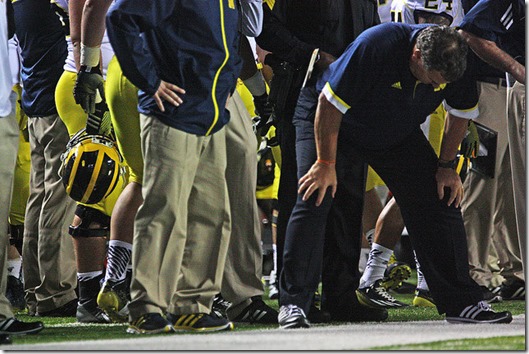
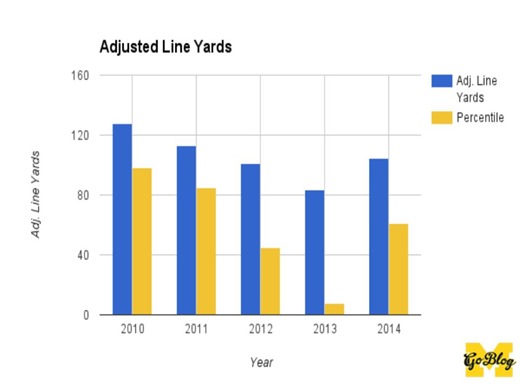
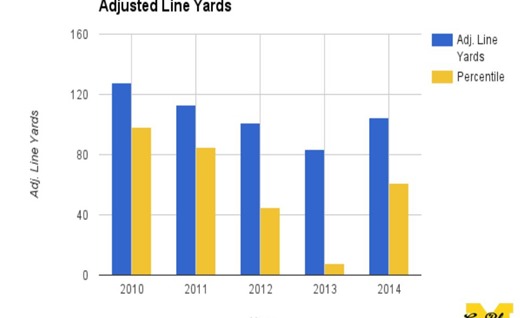

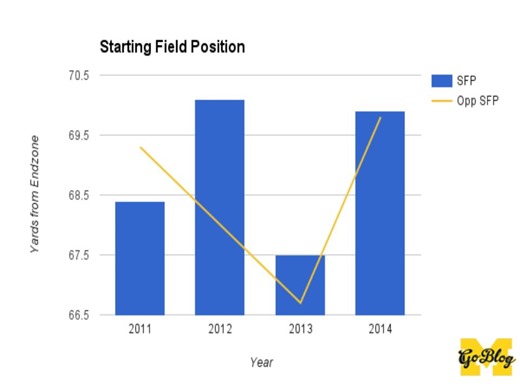
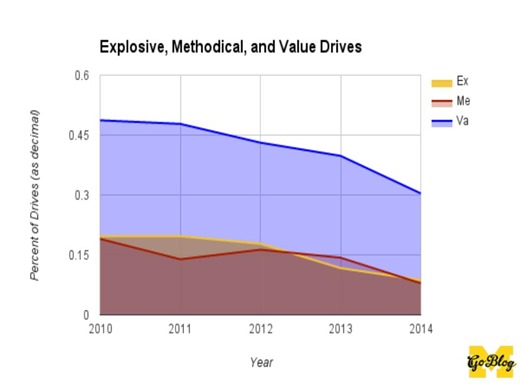
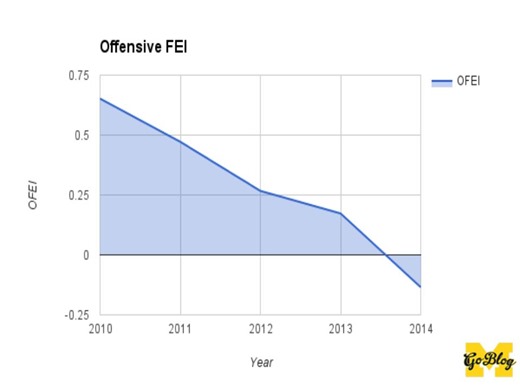
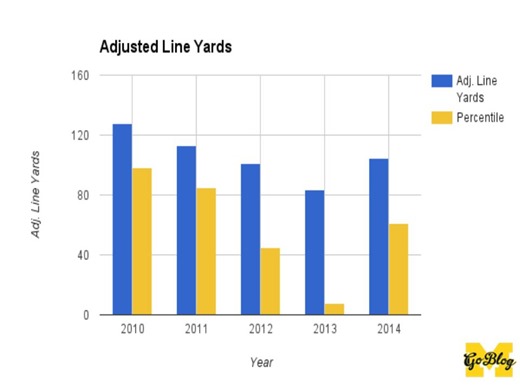

Comments